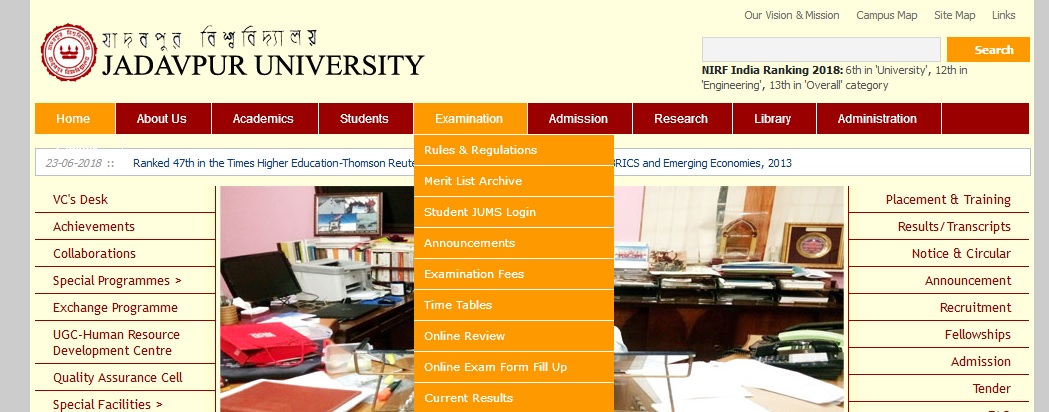Food Biotechnology B.Tech Question Paper : jaduniv.edu.in
Name of the University : Jadavpur University
Department : Food Tech & Bio-Chemical Engineering
Degree : B.Tech
Subject Name : Food Biotechnology
Sem : II
Website : jaduniv.edu.in
Document Type : Model Question Paper
Download Model/Sample Question Paper : https://www.pdfquestion.in/uploads/dspace.jdvu.ac.in/6165-FOOD%20BIOTECHNOLOGY_Seme2_2005.pdf
Jadavpur Food Biotechnology Question Paper
B. Tech. (Ftbe) Final Examination, 2005 :
( 2nd Semester )
Time : Three hours
Full Marks : 100 (50 Marks for each part)
Related : Jadavpur University Food Microbiology B.Tech Question Paper : www.pdfquestion.in/6164.html
Use a separate Answer-Script for each part :
PART – I
Answer any three questions
All Questions carry equal marks
1. Explain the following:
i) Application of r-DNA technology in Food Production & Processing.
ii) Tissue culture technique has become important in Quality Food Production in Agriculture.
2. Discuss possible use of biopreservative in Food. How it is different from antibiotics ? Explain production of any one of biopreservatives.
3. Explain the enzymic hydrolysis of protein is important for fabrication of different foods. How will you measure degree of hydrolysis of protiens. Explain modification of enzymic hydrolysis of proteins can be made using r-DNA technology.

4. Discuss the kinetics of Lactic acid production. Discuss the use of Lactic acid bacteria in different food system. What is biopolymer ?
5. Write short notes on :
a) Single cell protein is important in World Food Chain.
b) Modification & use of Corn syrup.
PART – II
Answer any three questions :
All Questions carry equal marks :
6. What do you mean by the term ‘Single cell protein” ? Discuss the possibility of production of single cell protein from different sources. Write down the prospects of SCP in food chain. What are the barriers for acceptance of SCP in food ?
7. What is HPLC ? Give a neat flowsheet diagram of a typical system of HPLC. Describe the different parts and accessories of HPLC with their function. Write down its application in food analysis.
8. What are the essential factors of algal growth ? Describe the process of production of algae from wastes including recovery process.
9. Why fermented foods are so popular ? Classify the fermented foods. Outline the biotechnological process for production of a fermented food from cereal and a milk beverage.
10. Write short notes on (any two)
a) Application of GLC in food analysis.
b) Preparation of Yogurt.
c) Use of immobilized enzyme in food biotechnology.
d) Spectrophotometer.
Syllabus
Food Analysis Laboratory :
Extraction, separation and identification, water and oil soluble dyes. Detection and estimation of additives in food materials net as, boric acid, benzoates, ulphites, formaldehyde, formic acid, lactic acid, saccharine cyclamate, dulcin etc. Analysis of following food stuffs : with reference to the standards of quality fixed for these : milk, jam, jelly, squash, vinegar, cider, rice and wheat.Changes in the vitamins ascorbic acid and thiamin in canned vegetables during thermal treatment. Available lysine content in fish-meal.
Technology Of Foods-III Syllabus : (Dairy Technology)
Chemical composition and nutritive value and physical characteristic of milk and ilk products. Handling of fresh milk. Pasteurization of milk. Homogenization of milk. Manufacture of milk products like condensed, evaporated and dried milk, creamed, butter ghee, ice cream. Fermented milk products. Technology ofcheese. Fortification of milk products. Production of infant milk food. Imitation milk. Quality control in milk and milk products including various analytical techniques of determination of milk quality. Milk plant hygiene and sanitation. Plant of dairy waste.
Technology Of Foods-V Syllabus : ( Tech. Of Oils And Fats):
Status of oils and fats and Indian economy. General chemistry, Analytical methods for characterization. Quality standards of edible oils and fats. Antioxidants and rancedity and fats indiet, nutrition and disease. Detection of adulteration.Extraction and clarification of vegetable oil. Modifications of the properties of oils and fats incuding chemical and biotechnological processes. Confectionery plastic fats. Preparation of various products including different shortenings, margarine, salad dressing and mayonnaise, imitation of dairy products low calorie spreads. Animal fat, oil derivatives. Technology of oilseed protein isolate.